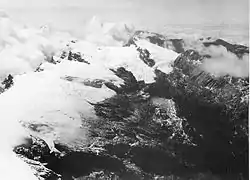West Northwall Firn
The West Northwall Firn was a glacial body on Mount Carstensz in the Sudirman Range on the island of New Guinea in Papua province, Indonesia. The glacier was situated at an elevation of approximately 4,600 metres (15,100 ft) to 4,750 metres (15,580 ft), centered a little over 3 kilometres (1.9 mi) northwest of Ngga Pulu and 5 kilometres (3.1 mi) of Puncak Jaya (Carstensz Pyramid), the highest peak of Oceania.


| West Northwall Firn | |
|---|---|
 The West Northwall Firn is the small patch of ice at right center in this 2005 image. The circular depression to the left is the Grasberg mine, the world's largest gold mine | |
| Type | Mountain glacier |
| Location | Puncak Jaya, Sudirman Range, Papua province, Indonesia |
| Coordinates | 04°03′3.69″S 137°09′33.93″E |
| Area | 0.28 km2 (0.11 sq mi) (2002)[1] |
| Terminus | Rockfall |
| Status | Vanished in or before 2017 |
Sometime between 1936 and 1962, a single Northwall Firn split into several separate glaciers, the largest being the West Northwall Firn and the East Northwall Firn. Research presented in 2004 of IKONOS satellite imagery of the New Guinean glaciers indicated that in the two years from 2000 to 2002, the West Northwall Firn had lost a further 19.4% of its surface area.[1] An expedition to the remaining glaciers on Puncak Jaya in 2010 found that the glacial ice was about 32 metres (105 ft) thick and thinning at a rate of 7 metres (23 ft) annually. At that rate, the remaining glaciers in the immediate region near Puncak Jaya were expected to last only to the year 2015.[2][3] Indeed, in or before 2017, the West Northwall Firn had completely disappeared.[4]
The West Northwall Firn was a remnant glacier of an icecap that in 1850 measured about 20 km2 (7.7 sq mi) and had developed approximately 5,000 years ago. At least one previous icecap also existed in the region between 15,000 and 7,000 years ago, when it also apparently melted away and disappeared.[1]
References
- Kincaid, Joni L.; Andrew G Klein (2004). "Retreat of the Irian Jaya Glaciers from 2000 to 2002". 61st Eastern Snow Conference: 147–157. CiteSeerX 10.1.1.694.7887.
- McDowell, Robin (July 1, 2010). "Indonesia's Last Glacier Will Melt 'Within Years'". Jakarta Globe. Retrieved 2011-10-23.
- "Papua Glacier's Secrets Dripping Away: Scientists". Jakarta Globe. July 2, 2010. Retrieved 2011-10-23.
- Kathryn Hansen, Glaciers in the Tropics, but Not for Long, at NASA Earth Observatory, February 13, 2018